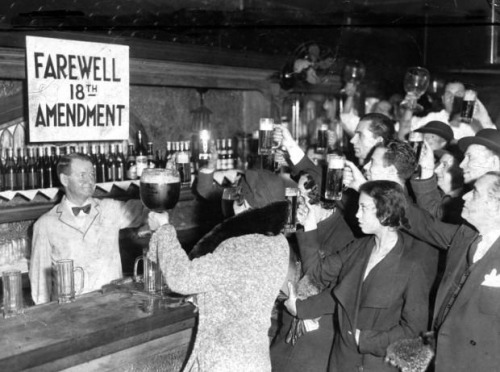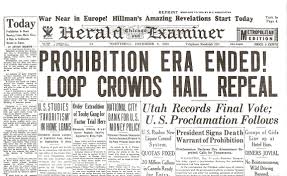Today marks the 94th anniversary of the 18th Amendment. So much of how Americans think about drinking today stems from the prohibition, so it’s important to not only celebrate its repeal, but learn about what caused the country to add the amendment in the first place.
A Plague of Drunkenness
 For nearly a decade prior to the 18th amendment, much of the country was plagued by drunkenness. I don’t mean good old fashioned Friday night cocktails where someone has to take a cab home and passes out on the floor in the kitchen. I mean men getting paid on Friday and heading to the saloon (where women were not allowed, by the way) and drinking away every single penny of their earnings. To make matters worse, the men who made it home (many often ended up in gutters or alleyways), often beat or berated their wives and children. The concept of divorce, marital rape, and help for battered women hadn’t even crossed anyone’s mind yet, so you can imagine what sort of things went on that no one ever talked about.
For nearly a decade prior to the 18th amendment, much of the country was plagued by drunkenness. I don’t mean good old fashioned Friday night cocktails where someone has to take a cab home and passes out on the floor in the kitchen. I mean men getting paid on Friday and heading to the saloon (where women were not allowed, by the way) and drinking away every single penny of their earnings. To make matters worse, the men who made it home (many often ended up in gutters or alleyways), often beat or berated their wives and children. The concept of divorce, marital rape, and help for battered women hadn’t even crossed anyone’s mind yet, so you can imagine what sort of things went on that no one ever talked about.
Women Take Up a Cause
 That is until the temperance movement came along. The movement was started by many of the women who were most negatively affected by the plague of drunkenness, and they did a great job convincing lots of municipalities, saloon owners, and other regular people – men and women – to take up moderate drinking or Total abstinence from alcohol. In fact, it is from the latter that the term Teetotaler stems (capital-T Total abstinence turned to teetotaler).
That is until the temperance movement came along. The movement was started by many of the women who were most negatively affected by the plague of drunkenness, and they did a great job convincing lots of municipalities, saloon owners, and other regular people – men and women – to take up moderate drinking or Total abstinence from alcohol. In fact, it is from the latter that the term Teetotaler stems (capital-T Total abstinence turned to teetotaler).
The Anti-Saloon League
The fight to get rid of the saloons and drinking went through plenty of phases throughout the 19th century, but it wasn’t until the Anti-Saloon league showed up on the scene in 1893 that it really started to make a real difference. The reason? The Anti-Saloon League was run by men, and men could vote. It also didn’t hurt that they were powerful guys who had no problem making deals and hurting anyone who got in their way.
Making an Amendment
 Mostly a state issue throughout the early 20th century, the temperance movement went into action after the start of World War I. Since many American brewers were German, the Anti-Saloon league took advantage of anti-German sentiments and went to work on the U.S. Congress. The 18th Amendment passed in December 1917 with many progressives believing it would not receive the state ratification (three-fourths) it needed in the time allotted – six years. It took only one.
Mostly a state issue throughout the early 20th century, the temperance movement went into action after the start of World War I. Since many American brewers were German, the Anti-Saloon league took advantage of anti-German sentiments and went to work on the U.S. Congress. The 18th Amendment passed in December 1917 with many progressives believing it would not receive the state ratification (three-fourths) it needed in the time allotted – six years. It took only one.
Ratified on January 16, 1919 and officially put in affect on January 17, 1920, the 18th Amendment banned “the manufacture, sale, and transportation of alcoholic beverages in the United States and its possessions.” It did not make owning or purchasing alcohol illegal, and individuals could keep any booze already in their possession.
A misnomer of the 18th Amendment is the Volstead Act. The Volstead Act was actually a separate law detailing the enforcement of the 18th Amendment.
In the end, despite a solid original goal of ridding the country of drunkenness and the family-hurting saloon, the 18th Amendment was a disaster, causing more organized crime, corruption, and hypocrisy than the U.S. had seen to that point. It was repealed on December 5, 1933 by the 21st Amendment.
















